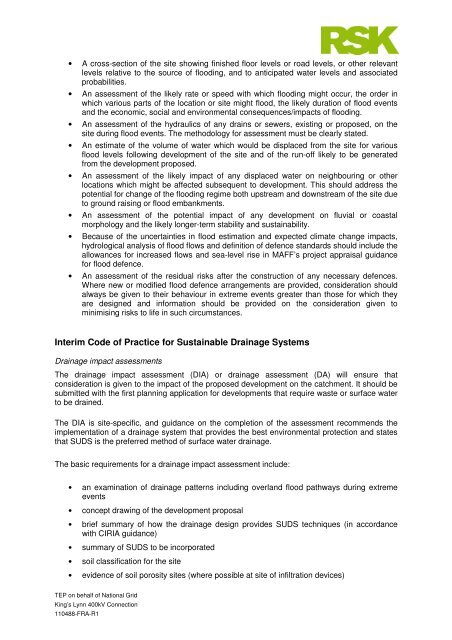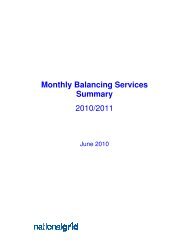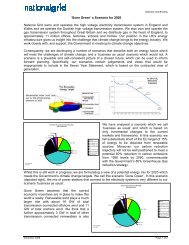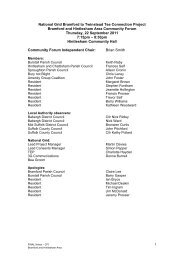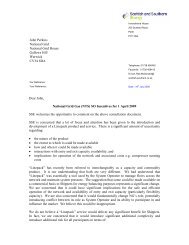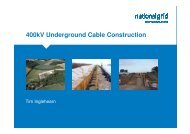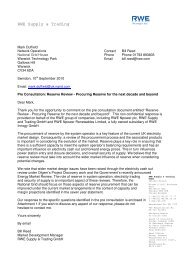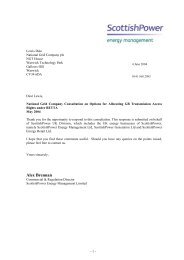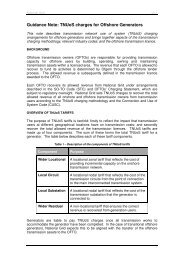appendix a - National Grid
appendix a - National Grid
appendix a - National Grid
Create successful ePaper yourself
Turn your PDF publications into a flip-book with our unique Google optimized e-Paper software.
• A cross-section of the site showing finished floor levels or road levels, or other relevant<br />
levels relative to the source of flooding, and to anticipated water levels and associated<br />
probabilities.<br />
• An assessment of the likely rate or speed with which flooding might occur, the order in<br />
which various parts of the location or site might flood, the likely duration of flood events<br />
and the economic, social and environmental consequences/impacts of flooding.<br />
• An assessment of the hydraulics of any drains or sewers, existing or proposed, on the<br />
site during flood events. The methodology for assessment must be clearly stated.<br />
• An estimate of the volume of water which would be displaced from the site for various<br />
flood levels following development of the site and of the run-off likely to be generated<br />
from the development proposed.<br />
• An assessment of the likely impact of any displaced water on neighbouring or other<br />
locations which might be affected subsequent to development. This should address the<br />
potential for change of the flooding regime both upstream and downstream of the site due<br />
to ground raising or flood embankments.<br />
• An assessment of the potential impact of any development on fluvial or coastal<br />
morphology and the likely longer-term stability and sustainability.<br />
• Because of the uncertainties in flood estimation and expected climate change impacts,<br />
hydrological analysis of flood flows and definition of defence standards should include the<br />
allowances for increased flows and sea-level rise in MAFF’s project appraisal guidance<br />
for flood defence.<br />
• An assessment of the residual risks after the construction of any necessary defences.<br />
Where new or modified flood defence arrangements are provided, consideration should<br />
always be given to their behaviour in extreme events greater than those for which they<br />
are designed and information should be provided on the consideration given to<br />
minimising risks to life in such circumstances.<br />
Interim Code of Practice for Sustainable Drainage Systems<br />
Drainage impact assessments<br />
The drainage impact assessment (DIA) or drainage assessment (DA) will ensure that<br />
consideration is given to the impact of the proposed development on the catchment. It should be<br />
submitted with the first planning application for developments that require waste or surface water<br />
to be drained.<br />
The DIA is site-specific, and guidance on the completion of the assessment recommends the<br />
implementation of a drainage system that provides the best environmental protection and states<br />
that SUDS is the preferred method of surface water drainage.<br />
The basic requirements for a drainage impact assessment include:<br />
• an examination of drainage patterns including overland flood pathways during extreme<br />
events<br />
• concept drawing of the development proposal<br />
• brief summary of how the drainage design provides SUDS techniques (in accordance<br />
with CIRIA guidance)<br />
• summary of SUDS to be incorporated<br />
• soil classification for the site<br />
• evidence of soil porosity sites (where possible at site of infiltration devices)<br />
TEP on behalf of <strong>National</strong> <strong>Grid</strong><br />
King’s Lynn 400kV Connection<br />
110488-FRA-R1


